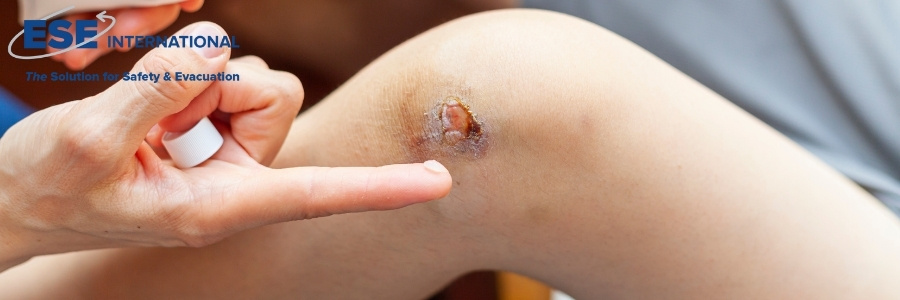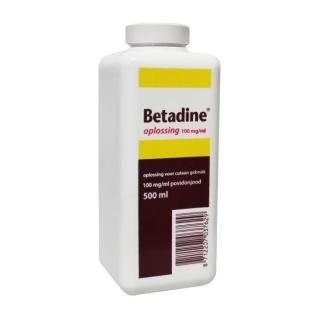Een schaafwond juist behandelen is belangrijk om infecties te voorkomen en het genezingsproces te bevorderen. Een schaafwond ontstaat wanneer de bovenste laag van de huid beschadigd raakt door wrijving met een ruw oppervlak.
Schaafwonden zijn vaak oppervlakkig, maar kunnen toch pijnlijk zijn. Daarom moeten ze op de juiste manier worden verzorgd om complicaties te voorkomen.
Wat is een schaafwond?
Een schaafwond is een oppervlakkige huidbeschadiging, waarbij de bovenste huidlaag is weg geschuurd. Dit type wond ontstaat door schaven over een ruw oppervlak, zoals asfalt en grind. Schaafwonden komen in verschillende gradaties voor, van kleine oppervlakkige schaafwonden die weinig bloeden, tot diepere schaafwonden die meer pijn doen en heviger bloeden.
Een schaafwond is te herkennen aan kleine puntbloedingen en krassen in de huid. Dit gaat gepaard met een rode huid, eventueel lichte zwelling en wondvocht.
Wat heb ik nodig voor de behandeling van een schaafwond?
Om een schaafwond goed te kunnen behandelen, heb je de volgende materialen nodig:
- Schoon lauw water
- Steriel pincet (indien nodig voor het verwijderen van vuil)
- Milde desinfecterende oplossing (zoals jodium of chloorhexidine)
- Steriele gaasjes
- Pleisters of steriel verband
- Vaseline of een andere wondzalf
Schaafwond behandelen, zo doe je dat
Ga je een schaafwond behandelen? Dan is het belangrijk dat je dit juist doet. Dit om infecties te voorkomen en de wond goed te laten genezen. Volg daarom onderstaande stappen om een schaafwond op de juiste manier te verzorgen.
Stap 1: schaafwond schoonmaken
Het schoonmaken van een schaafwond is een van de belangrijkste stappen. Je doet dit door de wond voorzichtig te spoelen met lauw stromend water. Dit helpt om vuil en bacteriën uit de wond te spoelen.
Zorg dat je geen zeep direct op de wond gebruikt, dit kan de huid irriteren. Als er nog vuil in de wond zit na het spoelen, kun je een steriel pincet gebruiken om dit voorzichtig te verwijderen.
Stap 2: wond desinfecteren
Na het schoonmaken van de schaafwond kan je de wond desinfecteren. Gebruik hiervoor een milde desinfecterende oplossing, zoals jodium of een chloorhexidine-oplossing.
Het aanbrengen doe je door het desinfectiemiddel voorzichtig op de wond te deppen met een steriel gaasje. Zo voorkom je dat bacteriën in de wond terechtkomen en een infectie veroorzaken.
Stap 3: afdekken van de wond (optioneel)
In veel gevallen is het niet nodig dat je een schaafwond afdekt, het is namelijk beter dat de wond aan de lucht kan drogen. Echter, als de schaafwond zich op een plek bevindt waar kleding ertegenaan schuurt of de kans is dat de wond in contact komt met vuil, dan is het verstandig om de wond af te dekken met een steriel verband of een pleister.
Zorg ervoor dat je het verband regelmatig vervangt, en probeer toch altijd de schaafwond aan de lucht te laten drogen.
Stap 4: verzorgen van de wond
Om het genezingsproces te bevorderen, kun je de wond soepel houden door deze in te smeren met een dun laagje vaseline. Dit voorkomt uitdroging van de wond en helpt bij het voorkomen van korstvorming die de huid kan straktrekken en het genezingsproces kan vertragen.
Wanneer moet je een huisarts inschakelen?
Veel schaafwonden zijn prima thuis te behandelen, echter het kan zijn dat je door een medisch professional behandelt moet worden. In de volgende gevallen is het raadzaam om contact op te nemen met een huisarts:
- Bij extreme vervuiling van de wond en straatvuil. Het kan zijn dat de wond besmet is met de tetanusbacterie. In dat geval kan het nodig zijn dat je een tetanusvaccinatie nodig hebt.
- Bij hevig bloeden van de schaafwond of een zeer diepe schaafwond.
- Als de pijn van de schaafwond blijft toenemen, de wond blijft zwellen, roodheid vertoond en pusvorming heeft. Dit kan duiden op een infectie van de wond.
Het genezingsproces van een schaafwond
Het genezingsproces van een schaafwond verloopt in verschillende fasen. Na het schoonmaken begint het lichaam de wond te herstellen door een korst te vormen.
Deze korst beschermt de onderliggende huid terwijl nieuwe huidcellen zich vormen. In de eerste dagen kan de wond rood en gevoelig zijn. Het is normaal dat er een kleine zwelling of lichte pijn aanwezig is. De korst zal vanzelf loslaten zodra de nieuwe huid is gevormd.
Dit proces kan enkele dagen tot een week duren, afhankelijk van de ernst van de schaafwond.
Nazorg van een schaafwond
Een schaafwond kan enkele dagen of langer zichtbaar blijven, afhankelijk van de diepte en de plaats van de wond. Het is belangrijk dat je de schaafwond regelmatig controleert op tekenen van infectie, zoals roodheid, zwelling, warmte of pusvorming.
Vermijd dat je aan de korst krabt, want dit kan de genezing vertragen en littekenvorming veroorzaken.
Probeer daarnaast te voorkomen dat de wond te lang nat blijft, zoals tijdens douche en het nemen van een bad. Dit kan namelijk de korst losweken nog voordat de huid volledig is hersteld.
Pijn verminderen van de schaafwond
Om de pijn van een schaafwond te verminderen, kun je een pijnstiller gebruiken, zoals paracetamol of ibuprofen. Het aanbrengen van een koud kompres op de wond kan ook helpen om de pijn en zwelling te verminderen, vooral direct na het oplopen van de schaafwond.
Schaafwond soepel houden
Wil je de schaafwond soepel houden en korstvorming minimaliseren? Dan kun je een dun laagje vaseline of een speciale wondzalf aanbrengen. Dit voorkomt dat je wond uitdroogt en helpt om de huid soepel te houden tijdens het genezingsproces.
Bescherming van schaafwond
Soms kan het nodig zijn om je schaafwond te beschermen tegen vuil en schurende kleding. In dat geval maak je gebruik van een pleister of een steriel verband.
Zo bescherm je de wond tegen verdere beschadiging en voorkom je dat er vuil in de wond komt. Tegelijkertijd verklein je zo de kans op een infectie.
Vervang het verband regelmatig en laat waar mogelijk je wond zoveel mogelijk aan de lucht drogen.
Medische disclaimer: De informatie in dit artikel is bedoeld als algemene richtlijn. Laat de behandeling van een schaafwond altijd over aan een bedrijfshulpverlener (BHV’er) of een andere gekwalificeerde persoon. Raadpleeg bij ernstige verwondingen of twijfel altijd een arts. In geval van ernstige pijn, hevig bloedverlies of tekenen van infectie, bel onmiddellijk 112 of zoek medische hulp.







